A Comprehensive Study of Aluminum Anodization in Transition Modes
Abstract
1. Introduction
2. Experimental Details
2.1. Anodization Pre-Treatment
2.2. Anodization
2.3. Characterization
3. Results and Discussion
4. Conclusions
Author Contributions
Funding
Institutional Review Board Statement
Informed Consent Statement
Data Availability Statement
Conflicts of Interest
References
- Wei, Q.; Fu, Y.; Zhang, G.; Yang, D.; Meng, G.; Sun, S. Rational Design of Novel Nanostructured Arrays Based on Porous AAO Templates for Electrochemical Energy Storage and Conversion. Nano Energy 2019, 55, 234–259. [Google Scholar] [CrossRef]
- Zhou, Z.; Nonnenmann, S.S. Progress in Nanoporous Templates: Beyond Anodic Aluminum Oxide and Towards Functional Complex Materials. Materials 2019, 12, 2535. [Google Scholar] [CrossRef] [PubMed]
- Goncharova, A.S.; Napolskii, K.S.; Skryabina, O.V.; Stolyarov, V.S.; Levin, E.E.; Egorov, S.V.; Eliseev, A.A.; Kasumov, Y.A.; Ryazanov, V.V.; Tsirlina, G.A. Bismuth Nanowires: Electrochemical Fabrication, Structural Features, and Transport Properties. Phys. Chem. Chem. Phys. 2020, 22, 14953–14964. [Google Scholar] [CrossRef] [PubMed]
- Shi, X.; Xiao, A.; Zhang, C.; Wang, Y. Growing Covalent Organic Frameworks on Porous Substrates for Molecule-Sieving Membranes with Pores Tunable from Ultra- to Nanofiltration. J. Membr. Sci. 2019, 576, 116–122. [Google Scholar] [CrossRef]
- Maghsodi, A.; Adlnasab, L.; Shabanian, M.; Javanbakht, M. Optimization of Effective Parameters in the Synthesis of Nanopore Anodic Aluminum Oxide Membrane and Arsenic Removal by Prepared Magnetic Iron Oxide Nanoparicles in Anodic Aluminum Oxide Membrane via Ultrasonic-Hydrothermal Method. Ultrason. Sonochem. 2018, 48, 441–452. [Google Scholar] [CrossRef] [PubMed]
- Kapruwan, P.; Ferré-Borrull, J.; Marsal, L.F. Nanoporous Anodic Alumina Platforms for Drug Delivery Applications: Recent Advances and Perspective. Adv. Mater. Interfaces 2020, 7, 2001133. [Google Scholar] [CrossRef]
- Tishkevich, D.I.; Vorobjova, A.I.; Shimanovich, D.L.; Vinnik, D.A.; Zubar, T.I.; Kozlovskiy, A.L.; Zdorovets, M.V.; Yakimchuk, D.V.; Trukhanov, S.V.; Trukhanov, A.V. Formation and Corrosion Properties of Ni-Based Composite Material in the Anodic Alumina Porous Matrix. J. Alloys Compd. 2019, 804, 139–146. [Google Scholar] [CrossRef]
- Malinovskis, U.; Poplausks, R.; Erts, D.; Ramser, K.; Tamulevičius, S.; Tamulevičienė, A.; Gu, Y.; Prikulis, J. High-Density Plasmonic Nanoparticle Arrays Deposited on Nanoporous Anodic Alumina Templates for Optical Sensor Applications. Nanomaterials 2019, 9, 531. [Google Scholar] [CrossRef] [PubMed]
- Kaur, S.; Law, C.S.; Williamson, N.H.; Kempson, I.; Popat, A.; Kumeria, T.; Santos, A. Environmental Copper Sensor Based on Polyethylenimine-Functionalized Nanoporous Anodic Alumina Interferometers. Anal. Chem. 2019, 91, 5011–5020. [Google Scholar] [CrossRef]
- Pol, L.; Eckstein, C.; Acosta, L.; Xifré-Pérez, E.; Ferré-Borrull, J.; Marsal, L. Real-Time Monitoring of Biotinylated Molecules Detection Dynamics in Nanoporous Anodic Alumina for Bio-Sensing. Nanomaterials 2019, 9, 478. [Google Scholar] [CrossRef] [PubMed]
- Sulka, G.D. Highly Ordered Anodic Porous Alumina Formation by Self-Organized Anodizing. In Nanostructured Materials in Electrochemistry; Ali, D.E., Ed.; Wiley: Weinheim, Germany, 2008; pp. 1–116. ISBN 9783527318766. [Google Scholar]
- Pashchanka, M.; Schneider, J.J. Origin of Self-Organisation in Porous Anodic Alumina Films Derived from Analogy with Rayleigh–Bénard Convection Cells. J. Mater. Chem. 2011, 21, 18761. [Google Scholar] [CrossRef]
- Belwalkar, A.; Grasing, E.; Vangeertruyden, W.; Huang, Z.; Misiolek, W. Effect of Processing Parameters on Pore Structure and Thickness of Anodic Aluminum Oxide (AAO) Tubular Membranes. J. Membr. Sci. 2008, 319, 192–198. [Google Scholar] [CrossRef] [PubMed]
- Sulka, G.D.; Stepniowski, W.J. Structural Features of Self-Organized Nanopore Arrays Formed by Anodization of Aluminum in Oxalic Acid at Relatively High Temperatures. Electrochim. Acta 2009, 54, 3683–3691. [Google Scholar] [CrossRef]
- Tripathy, J.; Wiley, J.B. Fabrication of Thick Porous Anodized Aluminum Oxide Templates. J. Solid State Electrochem. 2015, 19, 1447–1452. [Google Scholar] [CrossRef]
- Leontiev, A.P.; Roslyakov, I.V.; Napolskii, K.S. Complex Influence of Temperature on Oxalic Acid Anodizing of Aluminium. Electrochim. Acta 2019, 319, 88–94. [Google Scholar] [CrossRef]
- Lee, W.; Ji, R.; Gösele, U.; Nielsch, K. Fast Fabrication of Long-Range Ordered Porous Alumina Membranes by Hard Anodization. Nat. Mater. 2006, 5, 741–747. [Google Scholar] [CrossRef] [PubMed]
- Noormohammadi, M.; Arani, Z.S.; Ramazani, A.; Kashi, M.A.; Abbasimofrad, S. Super-Fast Fabrication of Self-Ordered Nanoporous Anodic Alumina Membranes by Ultra-Hard Anodization. Electrochim. Acta 2020, 354, 136766. [Google Scholar] [CrossRef]
- Zaraska, L.; Sulka, G.D.; Jaskuła, M. Anodic Alumina Membranes with Defined Pore Diameters and Thicknesses Obtained by Adjusting the Anodizing Duration and Pore Opening/Widening Time. J. Solid State Electrochem. 2011, 15, 2427–2436. [Google Scholar] [CrossRef]
- Chung, C.K.; Liao, M.W.; Chang, H.C.; Lee, C.T. Effects of Temperature and Voltage Mode on Nanoporous Anodic Aluminum Oxide Films by One-Step Anodization. Thin Solid Films 2011, 520, 1554–1558. [Google Scholar] [CrossRef]
- Dobosz, I. Influence of the Anodization Conditions and Chemical Treatment on the Formation of Alumina Membranes with Defined Pore Diameters. J. Porous Mater. 2021, 28, 1011–1022. [Google Scholar] [CrossRef]
- Roslyakov, I.V.; Gordeeva, E.O.; Napolskii, K.S. Role of Electrode Reaction Kinetics in Self-Ordering of Porous Anodic Alumina. Electrochim. Acta 2017, 241, 362–369. [Google Scholar] [CrossRef]
- Vega, V.; García, J.; Montero-Moreno, J.M.; Hernando, B.; Bachmann, J.; Prida, V.M.; Nielsch, K. Unveiling the Hard Anodization Regime of Aluminum: Insight into Nanopores Self-Organization and Growth Mechanism. ACS Appl. Mater. Interfaces 2015, 7, 28682–28692. [Google Scholar] [CrossRef] [PubMed]
- Bruera, F.A.; Kramer, G.R.; Vera, M.L.; Ares, A.E. Synthesis and Morphological Characterization of Nanoporous Aluminum Oxide Films by Using a Single Anodization Step. Coatings 2019, 9, 115. [Google Scholar] [CrossRef]

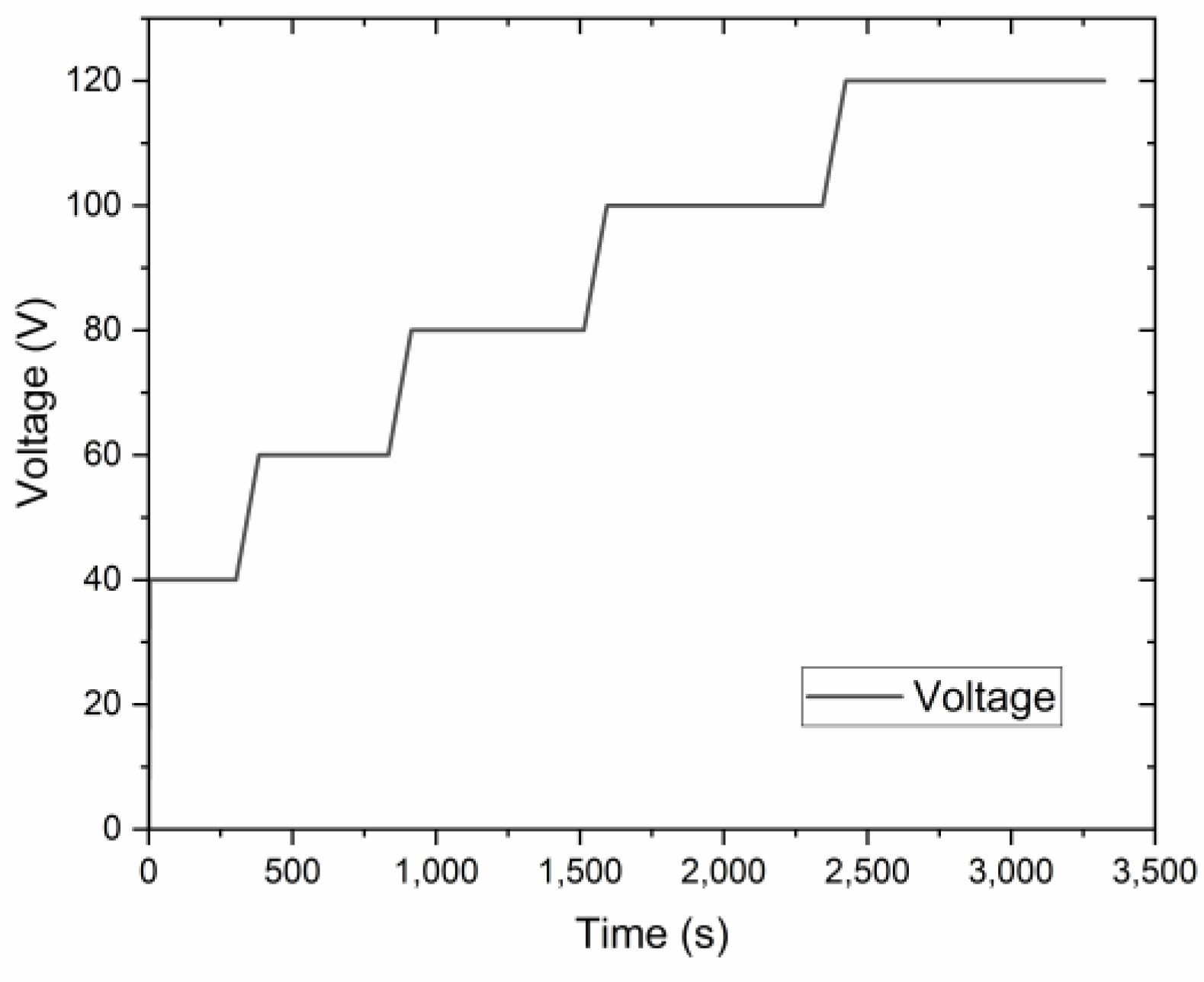

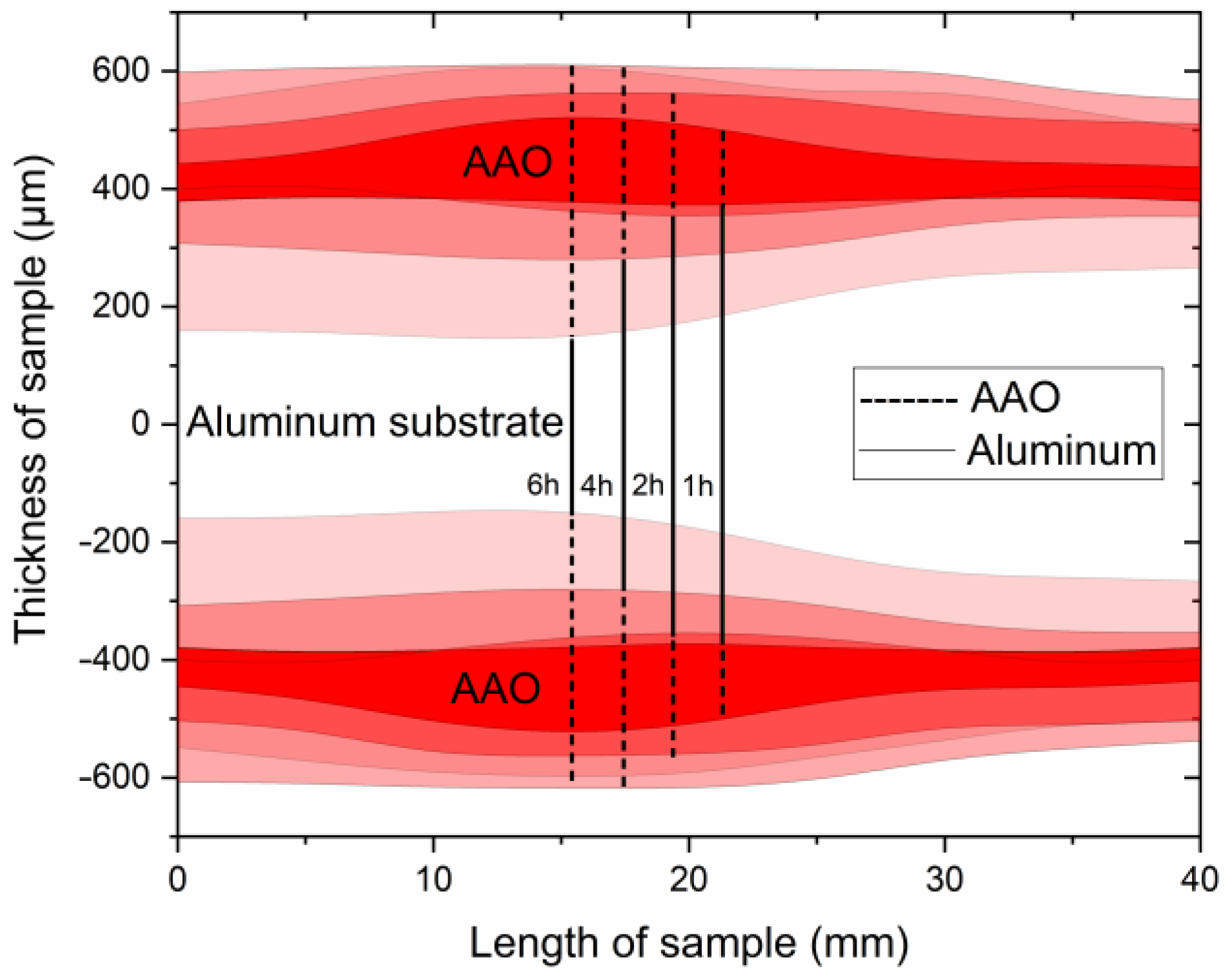

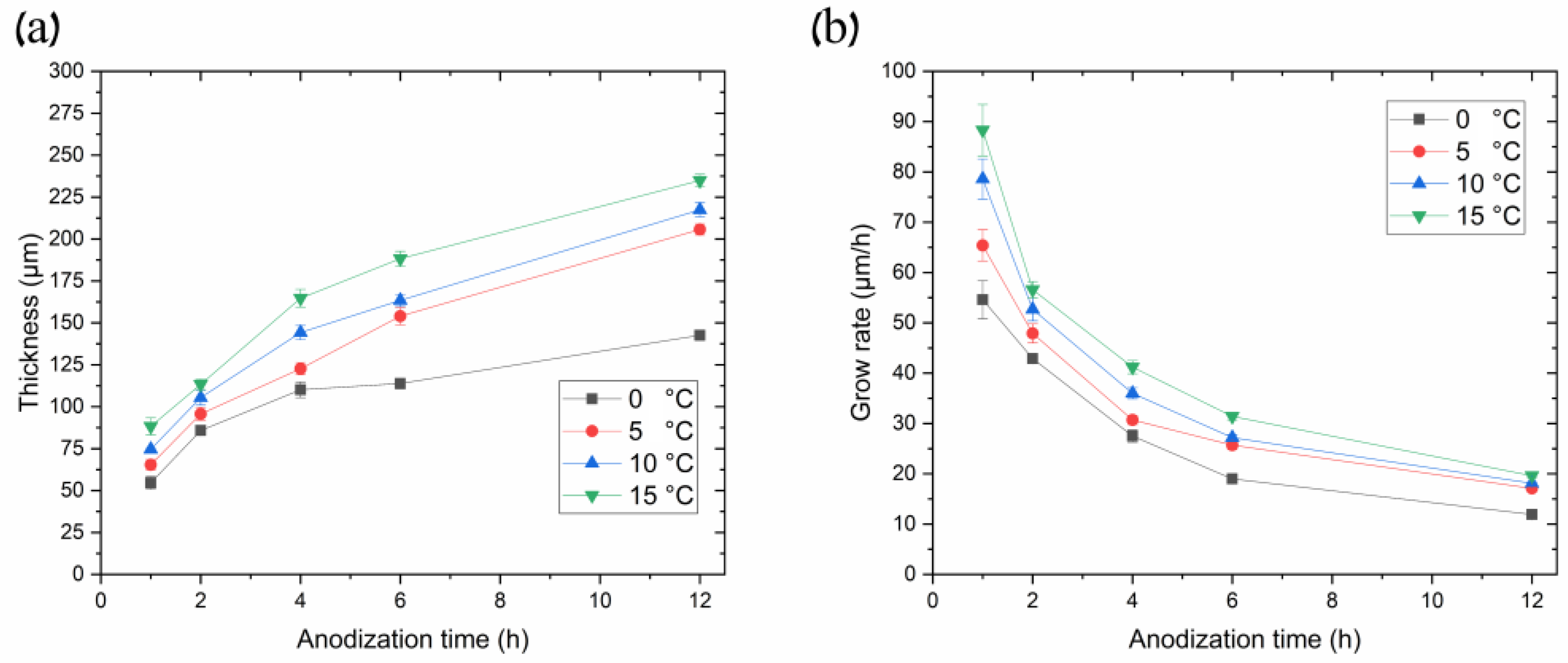


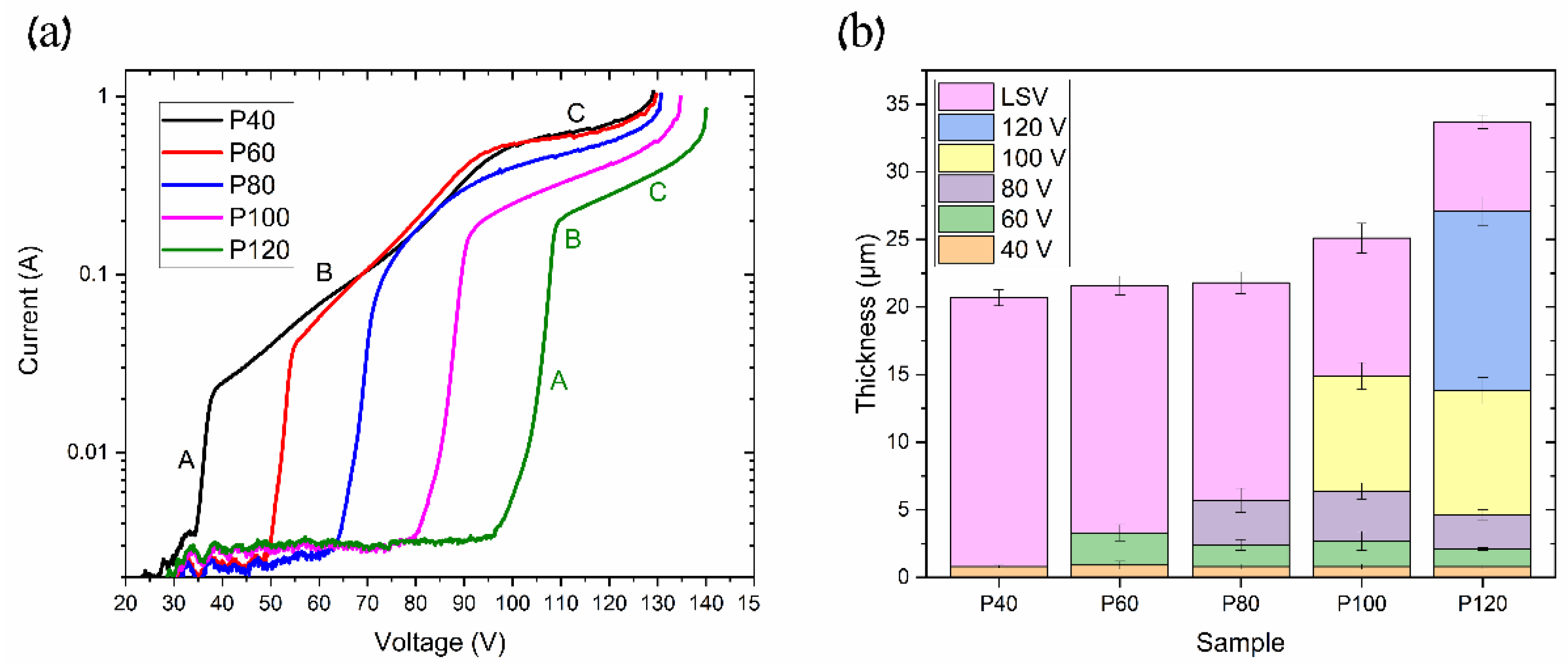
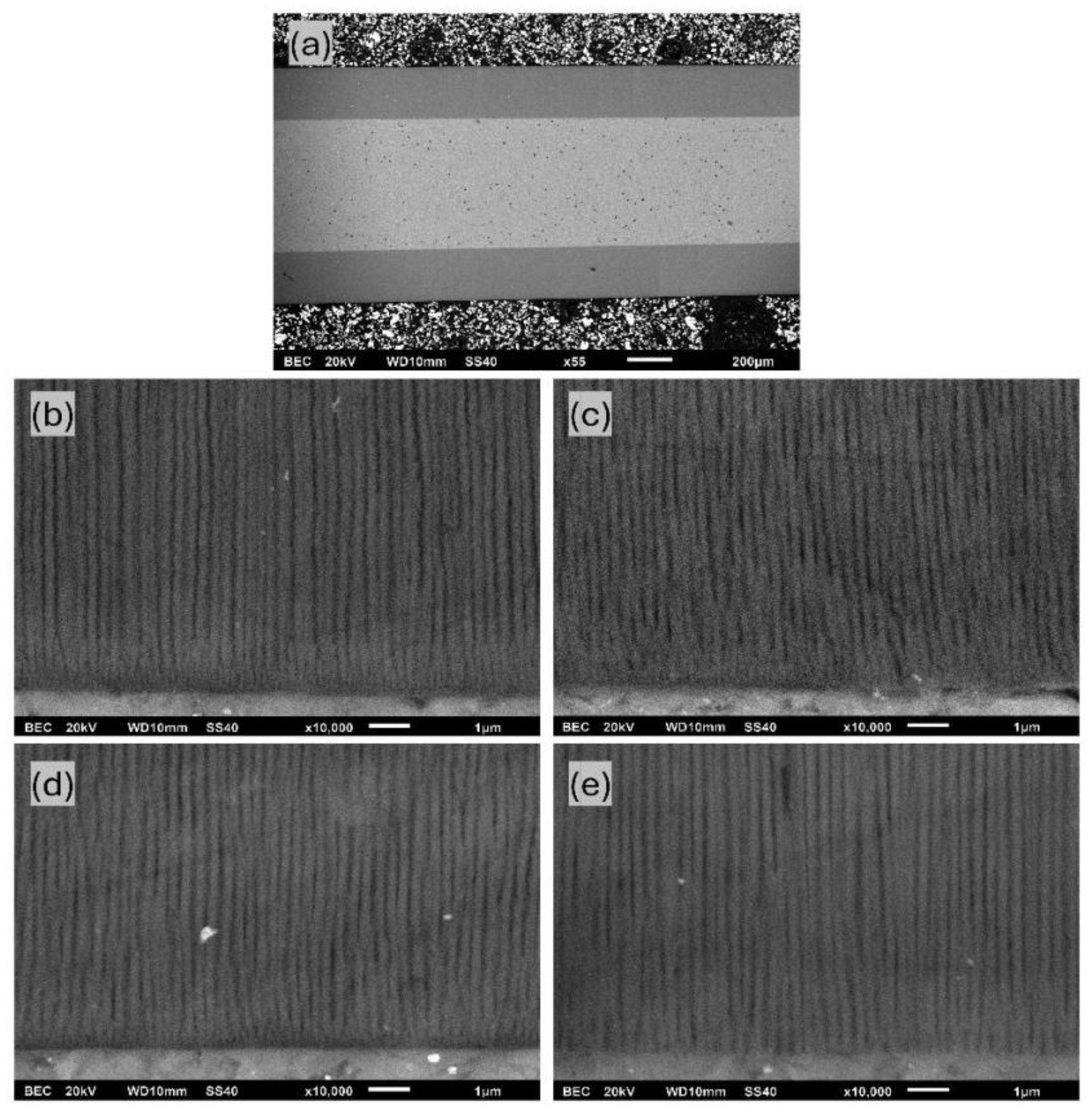
| 40 V | 60 V | 80 V | 100 V | 120 V | |
|---|---|---|---|---|---|
| P40 | 300 s | - | - | - | - |
| P60 | 300 s | 450 s | - | - | - |
| P80 | 300 s | 450 s | 600 s | - | - |
| P100 | 300 s | 450 s | 600 s | 750 s | - |
| P120 | 300 s | 450 s | 600 s | 750 s | 900 s |
| Pore Diameter (nm) | |||||
|---|---|---|---|---|---|
| 1 h | 2 h | 4 h | 6 h | 12 h | |
| 0 °C | 79.9 ± 10.7 | 85.7 ± 9.5 | 88.6 ± 9.4 | 103.2 ± 14 | 98.0 ± 10.3 |
| 5 °C | 86.4 ± 10.2 | 90.1 ± 15.0 | 96.1 ± 10.7 | 111.9 ± 14.3 | 108.7 ± 10.3 |
| 10 °C | 102.2 ± 15.2 | 99.0 ± 10.9 | 99.0 ± 14.3 | 115.6 ± 16.2 | 109.4 ± 15.6 |
| 15 °C | 123.6 ± 17.4 | 138.4 ± 14.6 | 139.1 ± 17.9 | 153.4 ± 20.6 | 155.9 ± 17.0 |
Disclaimer/Publisher’s Note: The statements, opinions and data contained in all publications are solely those of the individual author(s) and contributor(s) and not of MDPI and/or the editor(s). MDPI and/or the editor(s) disclaim responsibility for any injury to people or property resulting from any ideas, methods, instructions or products referred to in the content. |
© 2024 by the authors. Licensee MDPI, Basel, Switzerland. This article is an open access article distributed under the terms and conditions of the Creative Commons Attribution (CC BY) license (https://creativecommons.org/licenses/by/4.0/).
Share and Cite
Rozenblium, I.; Yuferov, Y.; Borodianskiy, K. A Comprehensive Study of Aluminum Anodization in Transition Modes. Materials 2024, 17, 3438. https://doi.org/10.3390/ma17143438
Rozenblium I, Yuferov Y, Borodianskiy K. A Comprehensive Study of Aluminum Anodization in Transition Modes. Materials. 2024; 17(14):3438. https://doi.org/10.3390/ma17143438
Chicago/Turabian StyleRozenblium, Ilia, Yuliy Yuferov, and Konstantin Borodianskiy. 2024. "A Comprehensive Study of Aluminum Anodization in Transition Modes" Materials 17, no. 14: 3438. https://doi.org/10.3390/ma17143438
APA StyleRozenblium, I., Yuferov, Y., & Borodianskiy, K. (2024). A Comprehensive Study of Aluminum Anodization in Transition Modes. Materials, 17(14), 3438. https://doi.org/10.3390/ma17143438







